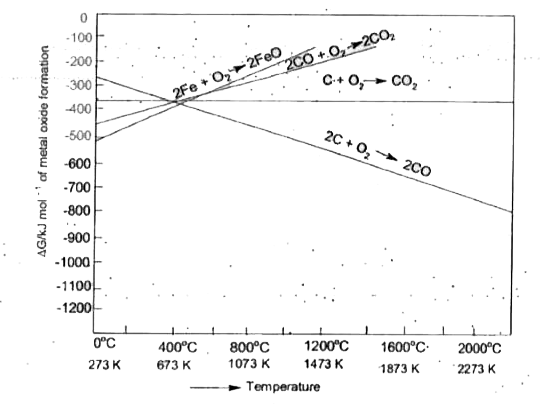Red hot carbon will remove oxygen from the oxide XO and YO but not from ZO. Y will remove oxygen from XO. Use this evidence to deduce the order of acitivity of the three metals X, Y and Z putting the most active frist:
XYZ
ZYX
YXZ
ZXY
The correct Answer is:B
Step by step video, text & image solution for Red hot carbon will remove oxygen from the oxide XO " and " YO but not from ZO. Y will remove oxygen from XO. Use this evidence to deduce the order of acitivity of the three metals X, Y and Z putting the most active frist: by Chemistry experts to help you in doubts & scoring excellent marks in Class 12 exams.
Updated on:21/07/2023Topper's Solved these Questions
- ELECTROCHEMISTRYBOOK - OP TANDONCHAPTER - ELECTROCHEMISTRYEXERCISE - OBJECTIVE TYPE QUESTION (LEVEL -B)
52 Videos
- ELECTROCHEMISTRYBOOK - OP TANDONCHAPTER - ELECTROCHEMISTRYEXERCISE - One or more than correct answer
19 Videos
- ELECTROCHEMISTRYBOOK - OP TANDONCHAPTER - ELECTROCHEMISTRYEXERCISE - PRACTICE PROBLEMS
94 Videos
- COORDINATION COMPOUNDSBOOK - OP TANDONCHAPTER - COORDINATION COMPOUNDSEXERCISE - SBJECTIVE TYPE
96 Videos
- HALOALKANES AND HALOARENES BOOK - OP TANDONCHAPTER - HALOALKANES AND HALOARENES EXERCISE - Single Interger answer type questions
14 Videos
Similar Questions
A black metal oxide XO2 is used as catalyst in the preparation of oxygen gas from potassium chlorate. The oxide XO2 is also used in ordinary dry cells. The metal oxide XO2 cannot be reduced satisfactorily with carbon to form metal X.
(a) Name the metal X.
(b) Name the metal oxide XO2
(c) Which reducing agent can be used to reduce XO2 to obtain metal X ?
(d) Name another metal which can also be extracted by the reduction of its oxide with the above reducing agent.
View SolutionThe process of converting a metallic oxide into a metal by removing the oxygen from the metallic oxide is called ____ or ____ .
View Solution
Knowledge Check
Red hot carbon will remove oxygen from the oxides XO and Yo but not from ZO.Y will remove oxygen from XO. Use this evidence to deduce the order of activity of the three metals X,Y, and Z, putting the most reactive first.
AX,Y,ZBZ,Y,XCY,X,ZDZ,X,YRed hot carbon removes oxygen from the oxide XO and YO but not from ZO. Y will remove oxygen from XO. Use this evidence to deduce the order of activity of the three metals X, Y and Z putting the most active first.
AX>Y>ZBZ>Y>XCY>X>ZDZ>X>YRed hot carbon will remove oxygen from the oxides XO and Yo but not from ZO.Y will remove oxygen from XO. Use this evidence to deduce the order of activity of the three metals X,Y, and Z, putting the most reactive first.
AX, Y, ZBZ,Y,XCY,X,ZDZ,X,Y
Red hot carbon will remove oxygen from the oxide AO and BO but not from MO, while B will remove oxygen from AO. The activity of metals A, B and M in decreasing order is
View SolutionRed hot carbon will remove oxygen from the oxide 40 and BO but not from MO, while B will remove oxygen from 40. The activity of metals A, B and M in decreasing order is
View SolutionA certain metal is present in the soil, plants, bones, egg shelts, sea shells and coral. It is also used to remove oxygen from molten steel and its hydroxide is used to detect Co2. The metal is
View SolutionMetals are extracted from their ores by a wide variety of techniques. The most common ores are oxides. Most metals are obtained by direct treatment of theirs ores with chemical agents, but the extraction of certain others require electrolysis. An example of the former type of process is the extraction of iron from its oxide, described by the following equation :
Fe2O3+3C→2Fe+3CO
The relative ease of extraction of a metal from its oxide can be estimated using the Ellingham diagram, as shown in the figure.
The diagram plots the free energies of formation of various oxides per mole of consumed oxygen as a function of absolute temperature.

All of the following reagents could be used to extract lead from its oxide except
View SolutionMetals are extracted from their ores by a wide variety of techniques. The most common ores are oxides. Most metals are obtained by direct treatment of theirs ores with chemical agents, but the extraction of certain others require electrolysis. An example of the former type of process is the extraction of iron from its oxide, described by the following equation :
Fe2O3+3C→2Fe+3CO
The relative ease of extraction of a metal from its oxide can be estimated using the Ellingham diagram, as shown in the figure.
The diagram plots the free energies of formation of various oxides per mole of consumed oxygen as a function of absolute temperature.
FIITJ∃CHEMB04_C02E07009_Q01.png width=80%><br>Whenferric⊗isreduced→obta∈ironmηl,CO_(2)orCOcanbe∏uced.The∏uctionofCO_(2)
View Solution
